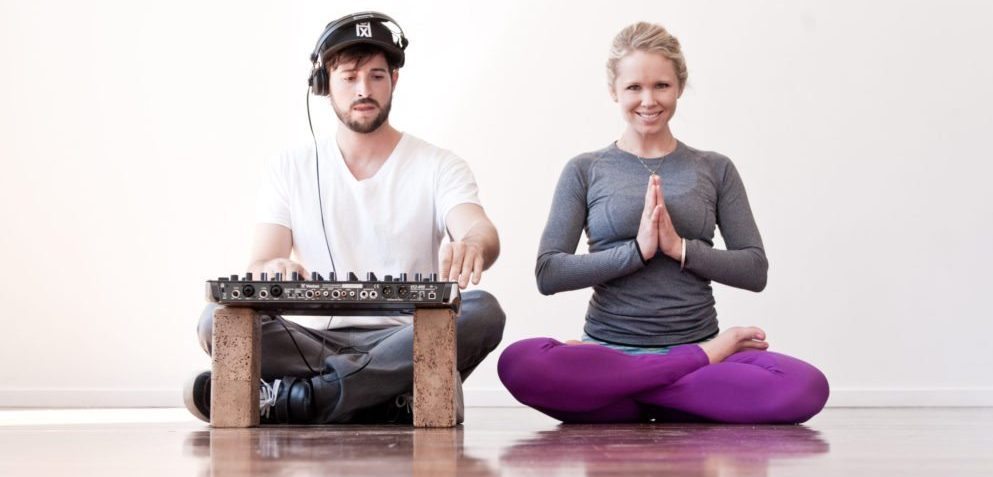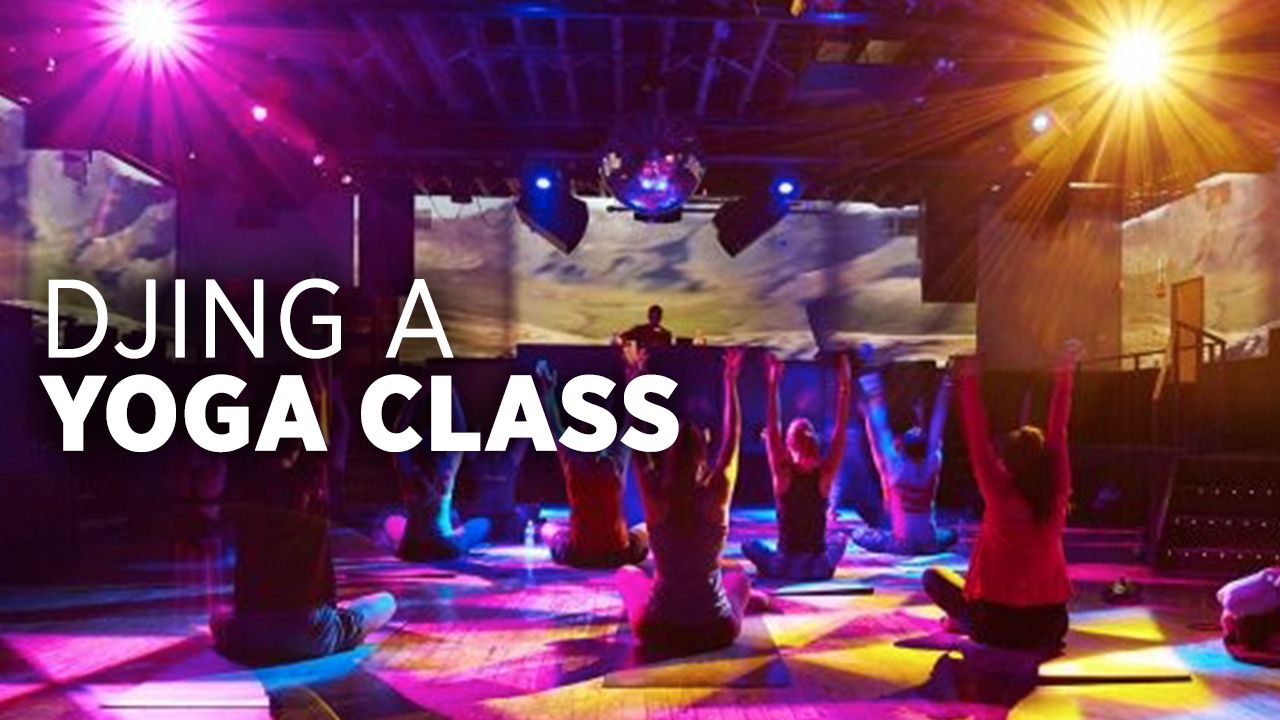DJs at yoga classes are becoming more common – but that doesn’t mean it’s an easy gig for any DJ to play. In today’s article, Ean Golden shares some insights from playing yoga sets and collaborating with instructors. Read on for four simple ways DJs can improve how they DJ yoga classes.
Why DJ Yoga Classes?
After nearly 20 years of DJing in clubs, festivals, and parties, I’ve been looking for new venues that are more in line with my personal life. With a focus wellness and spirituality, staying up until 6am and traveling constantly hasn’t been appealing for a while, and I’m pretty much retired from that circuit.

An unlikely place that has been working quite well for me is in the land of yoga. In a yoga class, there’s a captive, conscious audience – and much more friendly working hours. After DJing a dozen yoga classes over the past few years, I would like to share my knowledge with you.
DJTT reached out to a few active DJs who play yoga gigs as well for this article – look for tips from Flashflooder and Lola Villa as well as my own experiences.
What Is This Yoga/DJ Combo Like?
The class I play regularly is a fairly standard energetic vinyasa flow that lasts for 75 minutes. The difference is that the yoga teacher and I are interacting with each other throughout the class and improvising on the sequence of moves depending on the energy we notice in people that day.
“It’s not about keeping people dancing, being a show man, playing the new hit songs, or keeping people entertained. It’s about creating the proper mood and head space for the people and instructor in the class by finding the right vibe and tempo for the varying intensity level of the class flow” – Flashflooder
She might react to the music that’s playing and bring people up, or I might react to a seated posture and settle the mood down. I maintain a rolling sequence of songs that keep things interesting, and provide breaks (just like a dance floor) while the teacher is connecting appropriate poses for a quality physical experience. If we get synced up, the class gets the best of both worlds: a great teacher and a musical lift.
DJing A Yoga Class is Harder Than You Might Think!

What’s surprising about this style of DJ set is how hard it is to do well. Anyone can play basic music behind a teacher, but the results will be mediocre. Done well, live DJing in a yoga context is more mentally taxing than a traditional set because a DJ should constantly have four things in mind:
- Is the teacher speaking right now? What is he/she saying? Do I need to make room?
- What is my next mix in/out point and song?
- What is the current energy level of the room, and is it appropriate for the current musical direction?
- When is the next section? High or low energy, and where in a progression of moves are we?
Beyond the basic mixing, picking the next song, and maintaining good levels; I am also constantly reacting to the teacher and providing space for their instructions. The DJ needs to be ready to shift directions on a dime. Transitioning from an uptempo pumping vibe back to a more spacious relaxed mood – hopefully while mixing it all flawlessly.
The end results, when they work, are beautiful. It’s a similar energy to a dance floor, but with the added improvisation of a teacher who will throw you curve balls. There’s not much money in yoga, and especially not for a yoga DJ, but the personal reward is huge. It provides me with the opportunity to practice mixing in a challenging way.
“The biggest different [when playing a yoga class] is the rhythm. When playing a regular set, I either begin very slow and build it up […] At yoga, there has to be room for harmony, more than bass lines and higher intensity. There’s more space for slower, deeper tracks, or even the weirdest ambient stuff you would never play in the club. I also play tracks of 123 bpm but at 80(!) which makes the experiencing the track incredibly interesting – it becomes a whole new track basically.” – Lola Villa
Four things that any DJ can do to vastly enhance their DJ sets in a yoga context:
#1: Create Room For The Teacher

This is the biggest, and also most challenging. I have taken classes where the teacher is forced to shout over an oblivious DJ who is searching through his computer looking for the next track. Students can’t hear the teacher’s cues and end up getting lost in the flow.
In a yoga class, it’s very important
for the students to clearly hear the teacher’s instructions.
At the same time you want to the music to be loud and exciting, or at least very present. Here’s two ways to balance these two desires:
- Actively create room for the yoga teacher when they are speaking by live ducking
- Pick music that does not have a lot of conflicting vocals, spoken words, or frequencies in 2 – 5kHz range. Here is one example that I use a lot by the creative Stimming:
Live ducking is quite simple. Not with all words, but when a teacher is saying something important, slightly duck the volume levels of that deck by 30% or so. You can use the volume faders or filters (my favorite) to create space.
In a yoga set it’s possible to play with dynamics in a big way, bringing the volume up and down significantly based on when there is space. I will often keep the levels lower during instruction and the first part of a sequence. Then, when there is a strong moment, I’ll bring it back up and push the levels a bit for energy. Listen to this example set and see how I create room for her voice throughout:
#2: Pay Attention + Break Up The Mix

Like a pair of dancers working off each other, this is a two person art. Rather than responding to a dance floor, you need to work off the yoga teacher and whatever sequence of poses are currently happening. Some teachers will simply respond to the music you’re playing, but ideally it is an active “conversation”.
For example, in a vigorous vinyasa class, there are times when having a very energetic beat helps people maintain a high level of energy – but they’re likely to get exhausted. The teacher will probably switch to some seated poses for a while to let people cool down, and you should be ready to drop to a lower level pretty quickly. If possible, I like to really demarcate these sections with BPM changes, but sometimes just a shift in key or musical energy is enough.
These sections can sometimes be communicated in advance, but like a DJ, they are usually improvised on the fly. You have to be ready to shift gears quickly. I manage this by keeping my yoga music well tagged with energy levels and proper labels for moments like “opening” or “ending”.
There’s almost always a gentle intro and usually a relaxed shavasana (or corpse/lying pose) where people are in a serious resting state. Plan for these moments and come prepared with a few pre-selected ambient tracks that fit those moments.
#3. Plan 60% Of Your Set In Advance
Let’s be realistic. Ducking for the teacher all the time and reacting to the energy of the room is a full-time job. Add in searching for the next track and it becomes impossible.
As a result, I like to plan out many of my mixes, but not the full set. I’ll have a series of sequences planned (read more on this concept here) and can improvise on their order. This allows me to focus on the room, which is vitally important (as noted in the previous section).
Occasionally, I will go hunting for the next track, but almost always I get out of sync with the teacher and the current flow. The best ways around this are:
- Having a single playlist with 30-50 songs pre-selected for that day
- Having many of those pre-selected for mix “vignettes”
#4. Take Classes Yourself

Most of these techniques I learned by listening to other DJs while on the yoga mat myself. It’s really important to have context and understand the class you are playing. This isn’t a club, and treating it like one won’t work out well. I seriously recommend every DJ planning to play a class consider:
- Become personally familiar with the practice (especially guided classes)
- Go to several yoga classes with DJs to learn what works and what doesn’t
Attending other DJ-accompanied classes is best way to notice what style of songs really worked in a yoga context.
Some of these insights are often counter-intuitive to what a DJ might think. For example, I found I enjoyed older pop music with words that were fun and made me smile – but as a DJ that’s the last thing that might make it into a set.
“Go do yoga first and get acquainted with the sequence. Also, don’t be afraid of playing at 80 bpm, a lot of DJs out there are petrified by the idea of playing slow, people tend to believe that the vibes will go away or that people will not be wanting to move, that it will become chill-out music, which is bollocks.” – Lola Villa
There also are many different styles of yoga, each with their own flow and perspective. Any DJ who is considering playing a yoga class should first develop their own taste and unique composition.
More DJ Yoga Mixes
Here’s a few more mixes from the DJs who also contributed to this article beyond my own (embedded above):









